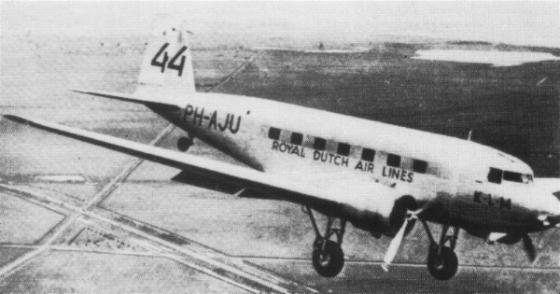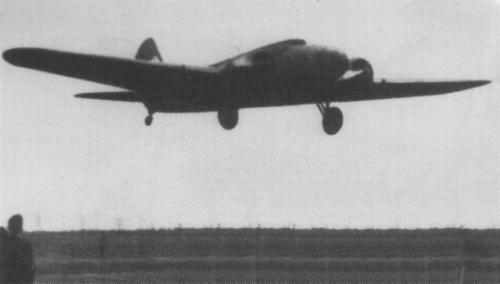The MacRobertson Air Race, 1934
England to Australia
The Third day
Scott and Campbell-Black, at Singapore, were leading by
1,300 miles. KLM's DC-2, captained by K.D. Parmentier, landed eight hours
behind them, and the KLM crew cut their fuelling time down to 30 minutes in
an effort to close the gap.

KLM's DC-2 PH-AJU 'Uiver'
When Scott and Campbell-Black's G-ACSS was halfway across the Timor Sea, the port engine began misbehaving and its oil pressure dropped to zero. Despite their efforts, that engine cut out, and they limped in to make Australian landfall at Darwin, N.T., where mechanics restored the engine sufficiently for "Grosvenor House" to take off. A thousand miles later, at 8:40 a.m. (twenty minutes before the Dutch reached Darwin), G-ACSS reached Charleville, Qld., where another two hours' work was put in on the ailing engine. Then they took off for Melbourne at 11 a.m.
Parmentier and crew, in the DC-2, left Darwin a thousand miles ahead of Roscoe Turner, whose aircraft checked out in Darwin despite his complaints of dropping oil pressure. The other remaining DH.88 Comet of Cathcart-Jones and Waller was crossing the Bay of Bengal and running fourth.
That afternoon, October 23rd, at 3:33 pm, G-ACSS reached Melbourne. Journalist Alan Dawes of the "Star" reported the event;-"Like a huge crimson-winged bullet, C.W.A. Scott's Comet, with T. Campbell-Black as co-pilot, dipped and swept across the finishing line at Flemington at 3:34 pm to-day, winner of the Centenary Air Race. "They had made the flight from England to Melbourne in two days, 23 hours 18 seconds. "Tumultuous cheering arose from the crowded stands at Flemington when a small speck appeared, developed into the unfamiliar shape of the Comet, and hurtled over the course."

Turner & Pangborn's Boeing 247-D NR257Y 'Warner Bros. Comet'
Parmentier saw the improvised flarepath and landed in heavy rain, and decided to wait for sunrise before attempting a takeoff.
Behind the Dutch aircraft, Turner and Pangborn had also been forced down, in their case by a smoking engine. Oil from a ruptured line was dropping onto hot metal. Turner telegraphed ahead for permission to fly without the cowl, and was told he could remove it, but must carry it on to Melbourne.
Turner left the cowl on and took off, his engine smoking, hoping to overtake the Dutch.